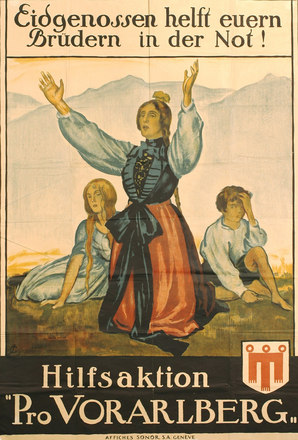-
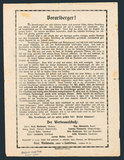
“Vorarlberger!” Leaflet in favour of unification of Vorarlberg with Switzerland, from 1919
Copyright: Vorarlberger Landesarchiv
-
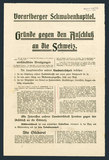
“Argument against unification with Switzerland”, announcement by the Vorarlberg Swabian Chapter against unification with Switzerland, 1919 (front)
Copyright: Vorarlberger Landesarchiv
-
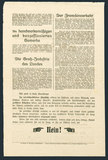
“Argument against unification with Switzerland”, announcement by the Vorarlberg Swabian Chapter against unification with Switzerland, 1919 (reverse)
Copyright: Vorarlberger Landesarchiv
-
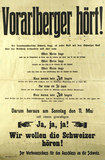
“Vorarlberger listen!” Poster for the Vorarlberg plebiscite on unification with Switzerland, held on 11 May 1919
Copyright: Vorarlberger Landesarchiv
When the Provisional National Assembly of German-Austria proclaimed the republic on 12 November 1918, the frontiers of the newly founded state were not yet certain.
According to the Fourteen Points drawn up by the American president Woodrow Wilson, the new political order in Europe was to be established on the basis of the right to national self-determination. In line with this demand, on 3 November 1918 the Provisional Provincial Assembly of Vorarlberg had already declared that the province was autonomous and that it was part of the state of German-Austria.
At the same time there arose a broadly based citizens’ action group which demanded that the province should join Switzerland. This was led by Ferdinand Riedmann from Lustenau, who on 13 November 1918 founded a Vorarlberg-wide ‘Committee to Campaign for Union with Switzerland’. On 1 March 1919 Riedmann presented to the provincial assembly a list of signatures which indicated that 70% of enfranchised citizens would support his campaign.
On 15 March 1919 the Provisional Provincial Assembly of Vorarlberg declared that affiliation with German-Austria was to be regarded as provisional only and that a plebiscite should determine any union with a larger state – with possible options apart from Switzerland being Bavaria and Württemberg. The provincial governor, Otto Ender, commented on this as follows:
I am of the opinion that, when we look at our geographical position, it is obvious that we are open towards Switzerland, not closed off from Germany, but definitely cut off by mountains from German-Austria.
In the referendum held on 11 May 1919, which asked whether Vorarlberg should negotiate with Switzerland on possible accession, 80% of voters were in favour of opening negotiations. It was only in Bludenz, Bolgendach and Hittisau that the majority of voters were against such talks. The catastrophic economic situation and the hope of an improvement as a result of union with Switzerland were probably the decisive reasons for the large ‘yes’ vote.
Opposition to the attempts to join Switzerland came from the German Freedom Party, the Pan-German Party and the representatives of the textile industry, who advocated union with Germany or the establishment of a Swabian state (with Württemberg). The Vorarlberger Schwabenkapitel (Vorarlberg Swabian Chapter), a society founded in April 1919, became the mouthpiece for their common cause, but the majority of the population did not support it.
However, neither the campaign for union with Switzerland nor the Schwabenkapitel could achieve any successes in practical political terms, as the power to decide the future frontiers of German-Austria lay in any case with the Paris peace conference. Although Provincial Governor Otto Ender was a member of the Austrian delegation in Paris, the Vorarlberg Question was only treated as a matter of secondary importance. Ender had in fact no power to negotiate: Chancellor Karl Renner wanted to prevent the loss of the province; Switzerland abstained from expressing support for Vorarlberg’s wish for union to the Allied powers at the peace negotiations; and even the French, who had initially indicated their readiness to agree, in the end came out against such a union.
The Treaty of Saint-Germain, signed by Chancellor Renner on 10 September 1919, made no provision for a plebiscite in Vorarlberg: the province was to remain with Austria. Further efforts by the people of Vorarlberg to get the League of Nations to agree to union with Switzerland also remained without success.
Translation: Leigh Bailey
Burmeister, Karl Heinz: Geschichte Vorarlbergs. Ein Überblick, 4. Auflage, München 1998
Goldinger, Walter/Binder, Dieter A.: Geschichte der Republik Österreich 1918-1938, München 1992
Graf, Stefan: Was blieb vom alten Österreich?, in: Natter, Tobias G. (Hrsg.): „Kanton Übrig“. Als Vorarlberg zur Schweiz gehören wollte, Bregenz 2008, 10-24
Häfele, Arnulf: Eine Landesverfassung als Eintrittskarte in die Eidgenossenschaft, in: Natter, Tobias G. (Hrsg.): „Kanton Übrig“. Als Vorarlberg zur Schweiz gehören wollte, Bregenz 2008, 36-43
Koch, Alexandra: Die Heimat ruft! Aber welche? Propagandistische Stilmittel nach dem 1. Weltkrieg in Österreich, in: Natter, Tobias G. (Hrsg.): „Kanton Übrig“. Als Vorarlberg zur Schweiz gehören wollte, Bregenz 2008, 54-64
Koller, Christian: „… der Wiener Judenstaat, von dem wir uns unter allen Umständen trennen wollen.“ Die Vorarlberger Anschlussbewegung an die Schweiz, in: Konrad, Helmut/Maderthaner, Wolfgang (Hrsg.): Das Werden der Ersten Republik … der Rest ist Österreich. Bd. I, Wien 2008, 83-102
Lang, Margarethe: Die Friedensverhandlungen in Paris und die Haltung der Alliierten, in: Natter, Tobias G. (Hrsg.): „Kanton Übrig“. Als Vorarlberg zur Schweiz gehören wollte, Bregenz 2008, 66-76
Pichler, Meinrad: Ferdinand Riedmann – Der Prophet vom gelobten Land Helvetia, in: Natter, Tobias G. (Hrsg.): „Kanton Übrig“. Als Vorarlberg zur Schweiz gehören wollte, Bregenz 2008, 44-52
Wanner, Gerhard: Vorarlberg, in: Weinzierl, Erika/Skalnik, Kurt (Hrsg.): Österreich 1918-1938. Geschichte der Ersten Republik, Bd. 2, Graz/Wien/Köln 1983, 1011-1041
Quotes:
"I am of the opinion that ...“: Stenographische Sitzungsberichte der provisorischen Vorarlberger Landesversammlung zu Bregenz. 14. Sitzung, 5, quoted from: Häfele, Arnulf: Eine Landesverfassung als Eintrittskarte in die Eidgenossenschaft, in: Natter, Tobias G. (Hrsg.): „Kanton Übrig“. Als Vorarlberg zur Schweiz gehören wollte, Bregenz 2008, 38 (Translation)
-
Chapters
- The High Price of Peace
- Tyrol Is Divided
- Burgenland Is Gained
- The defensive campaign in Carinthia and the plebiscite on 10 October 1920
- Losing Southern Styria
- Fixing the Northern Frontier
- Austrian Federal Province or Swiss Canton?
- Austrian attempts to unite with Germany from the founding of the republic to the referendums in Tyrol and Salzburg in 1921

